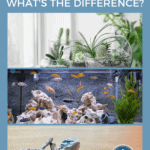Most people are familiar with using the term aquarium as another word for a fish tank. But what is a vivarium? And what is a terrarium? To show you the crucial differences between a terrarium vs. an aquarium, we’ve compiled this informative article.
In this guide, we explain the differences and similarities between a terrarium vs. aquarium vs. vivarium, as well as showing you how you could incorporate one of these diverse mini-ecosystems into your home.
Quick Comparison Chart
Here’s a comparison chart that illustrates the inhabitants of aquariums, terrariums, and vivaria in general.
Health Issue
Same Container
Environment
Humidity
CO2 injections
Water
Land
Plants
Aquatic animals
Semi-aquatic animals
Terrestrial animals
Aquarium
Yes
Water
–
Sometimes
Yes
No
Sometimes
Sometimes
No
No
Vivarium
Sometimes
Varied
Varied
Sometimes
Sometimes
Sometimes
Sometimes
Sometimes
Sometimes
Sometimes
Terrarium
Sometimes
Generally arid
Low
No
No/Little
Yes
Sometimes
No
No
Sometimes
Aquarium
Same Container
Yes
Environment
Water
Humidity
–
CO2 injections
Sometimes
Water
Yes
Land
No
Plants
Sometimes
Aquatic animals
Sometimes
Semi-aquatic animals
No
Terrestrial animals
No
Vivarium
Same Container
Sometimes
Environment
Varied
Humidity
Varied
CO2 injections
Sometimes
Water
Sometimes
Land
Sometimes
Plants
Sometimes
Aquatic animals
Sometimes
Semi-aquatic animals
Sometimes
Terrestrial animals
Sometimes
Terrarium
Same Container
Sometimes
Environment
Generally arid
Humidity
Low
CO2 injections
No
Water
No/ Little
Land
Yes
Plants
Sometimes
Aquatic animals
No
Semi-aquatic animals
No
Terrestrial animals
Sometimes
What Is A Vivarium?
According to the Oxford English Dictionary, the term “vivarium” is defined as:
“An enclosure, container, or structure adapted or prepared for keeping animals under semi-natural conditions for observation or study or as pets; an aquarium or terrarium.”
Vivariums come in many different forms and are named according to the type of habitat they offer and the kind of creatures that live in the environment. These biotopes are used to house fish, corals, crustaceans, reptiles, plants, and amphibians, and each has its own name.
What Is A Terrarium?
The term “terrarium” comes from the Latin word “Terra,” which translates as “earth.” The suffix “arium” is applied to any noun that describes an artificially created habitat in which plants or animals are kept. For example, you can see that the word “aquarium” clearly means a habitat that contains water (aqua), so it will be used to house aquatic creatures and plants.
Accidental Discovery
According to historical records, the very first terrarium was created by accident in 1842 by renowned botanist Nathaniel Bagshaw, an English medical doctor.
Dr. Bagshaw was studying the behavior of insects, keeping his specimens in glass jars. He left one of the jars unattended, with the result that a random plant spore germinated and grew into a plant. That jar became the world’s first terrarium!
Terrarium Environment
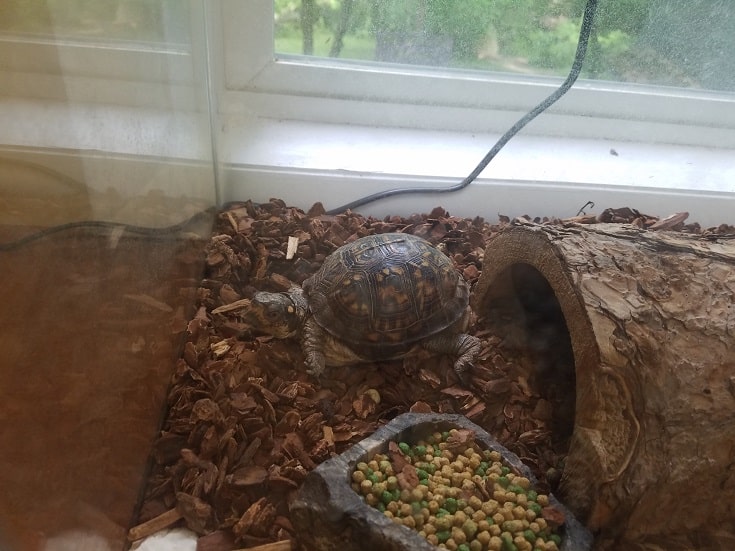
A terrarium is primarily a dry environment with low humidity that contains living plants. In essence, a terrarium is a small greenhouse that replicates the plants’ natural environment and habitat. Terrariums can also be used to keep certain species of animals too.
There are two types of terrarium; sealed and open.
Sealed Terrariums
A sealed terrarium is to be used only for plants. A sealed glass container is a self-sustainable ecosystem where the living plants, growing medium, air, and water all work together through water cycling, photosynthesis, and respiration. That said, a terrarium does have an opening door, allowing for maintenance when necessary.
Note that only land plants can be grown in a terrarium.
Open Terrariums
Sometimes, terrariums are used to house small land animals, such as lizards and the like. These types of containers need an airflow, so they are usually fitted with a mesh venting panel at the top and often to the lower part of the sides, too.
Animal species that are commonly housed in a terrarium include land snails, land crabs, spiders, ants, lizards, praying mantises, and scorpions.
Can A Terrarium Be Used As An Aquarium?
If you’re planning on setting up an aquarium from scratch, be very careful that you don’t buy a terrarium by mistake. Some terrariums may resemble a traditional glass fish tank or bowl, but they are often made of thinner glass and are not designed to take the pressure and weight of water and substrate.
How To Maintain A Terrarium
Terrariums are generally low-maintenance, although a small amount of maintenance is required to keep the plants inside healthy.
Trim away overgrowth to prevent the terrarium from becoming overcrowded, and remove any brown and yellow leaves that appear, as that can be a sign of disease or pest infestation. If you have a closed terrarium, you’ll need to remove the lid every so often to allow some fresh air to circulate.
Sometimes, gnats or mealybugs can infest terrariums. You can often deal with that problem by using insecticides, avoid overwatering your plants, and use rocks and pebbles to deter gnats. However, if that strategy fails, it’s best to remove the affected plant.
What Is An Aquarium?
An aquarium is the correct term that’s used to describe a container made of glass, acrylic, or plastic that’s used to house fish, corals, sponges, invertebrates, and aquatic plants.
Modern aquariums are fitted with a filtration system to keep the water clean and free from harmful toxins, a heater to keep the water warm for tropical fish, and a lighting unit to promote live plant growth.
Who Invented The Aquarium?
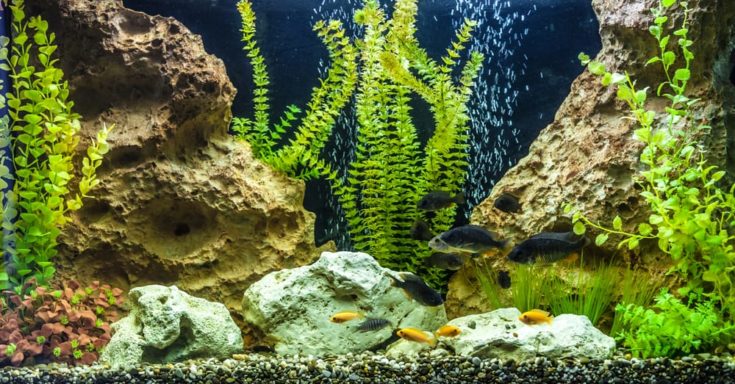
It’s thought that the very earliest aquariums were seen in the mid-1700s in England, where glass bowls were used to keep goldfish imported from The Orient. But it was nearly a hundred years later when fish keepers understood more about how to maintain a healthy closed ecosystem that housed fish and aquatic plants.
The first recognizable glass aquarium was created in 1832 by French naturalist Jeanne Villepreux-Power. However, before the carefully aquascaped aquarium became a common sight in homes, large display aquariums were created as exhibits that were open to the public. Many large cities around the world followed the lead of the Regent’s Park aquarium in London, England, which opened in 1853.
The famous circus owner, P.T. Barnum, opened the very first U.S. display aquarium in 1856 in New York City’s American Museum. The fishkeeping floodgates were opened, and before World War II, there were 45 public aquariums in cities around the world.
How To Maintain An Aquarium
Even a small nano aquarium requires regular maintenance to keep the environment safe and healthy for the fish and other creatures that live there.
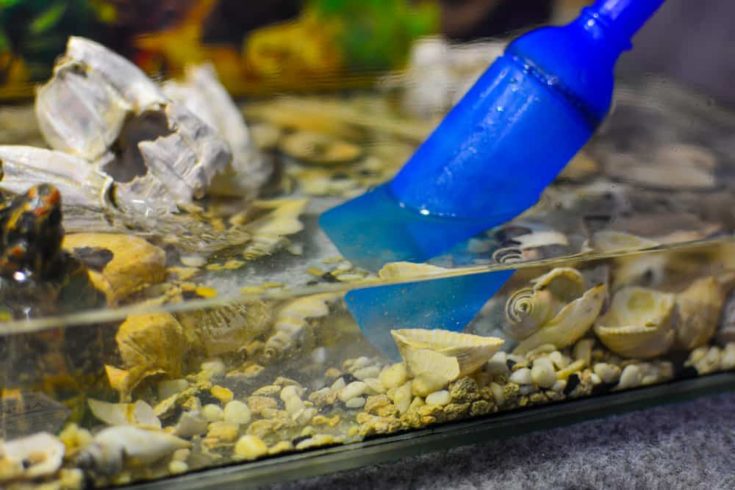
Every week, you’ll need to change up to 25% of the water in the tank and vacuum the aquarium gravel to remove fish waste, uneaten food, and general detritus. If you have live plants in your setup, they will require trimming and tidying up to prevent overgrowth. And once a month or so, you’ll need to rinse the filter media in tank water to remove sludge that would otherwise clog the filter.
Differences Between Terrariums And Aquariums
So, there are a number of important differences between terrariums and aquariums:
Construction
Terrariums are generally constructed of glass. Aquariums can be made of glass, plastic, or acrylic.
Crucially, the glass that’s used in aquarium construction is stronger than that used to create terrariums, as it must withstand the pressure and weight of the water, substrate, etc. inside. Consequently, aquariums are generally heavier and less portable than terrariums.
Shape
Terrariums can be bowl-shaped, multi-sided, square, or rectangular. Aquariums are generally bowls, rectangular, cuboid, bow-fronted, and multi-sided and are usually taller than terrariums.
Access
Terrariums are usually open to the front, allowing air to circulate around the plants and providing access for maintenance. However, some terrariums are enclosed, and those that contain creatures, such as spiders, lizards, and the like, are closed with mesh inserts to allow air circulation while preventing the occupants from escaping.
Aquariums are usually fully enclosed to prevent water evaporation, keep the residents safely inside, and prevent dust and dirt from falling into the water.
Waterproof
Because terrariums are not designed to hold water, they are not sealed. Aquariums must be properly sealed and fully waterproof to prevent leaks and cracking.
Other Kinds Of Vivariums
So, you’ve learned that a vivarium is a catch-all term that’s used to describe a vessel in which animals and or plants are kept for study or as pets. As well as aquariums and terrariums, there are many other kinds of vivariums, each with their own name:
Mossarium
Mosses are rootless plants that absorb the water and nutrients that they need through their leaves. Moss typically grows in damp, shady environments with limited light.
A mossarium is the name given to a mini self-sustaining ecosystem in which mosses are cultivated. The environment inside the mossarium is kept moist. As the water evaporates, it condenses on the walls of the glass container, forming droplets that are absorbed by the mosses growing inside.
Oceanarium
An oceanarium is a saltwater aquarium that’s used for displaying marine creatures and plants. The world’s first large public oceanarium was built in 1938 near St. Augustine, Florida.
Paludarium
A paludarium contains both plants and semi-aquatic or aquatic species, usually amphibians, fish, or reptiles, such as killifish, tree frogs, salamanders, mudskippers, and the like.
Riparium
A riparium is a planted tank that may contain wetland habitat, streams, and a shoreline where marginal plants can grow, including emersed and terrestrial species.
Curious to know how Riparium compares to Paludarium? You can learn about it here.
Insectarium
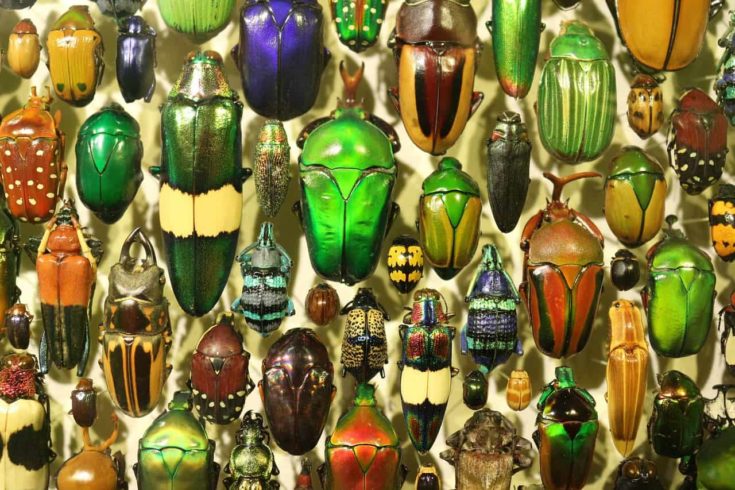
As you may have guessed, an insectarium is used for keeping insects for study purposes or as pets. For example, many school science labs keep a simple insectarium containing stick insects.
Formicarium
A formicarium is a vivarium that’s used to house ant colonies.
Penguinarium
Again, you guessed it! A penguinarium is a vivarium that’s designed to simulate the natural environment of penguins.
Dolphinarium
A dolphinarium is an aquarium where dolphins are kept, often as part of an oceanarium complex.
In Conclusion
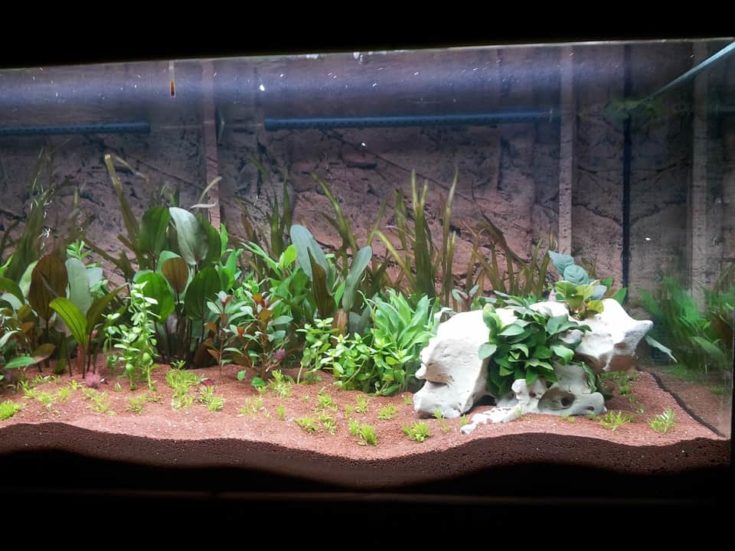
So, now you know that a vivarium is any container that’s used to create a habitat in which animals, insects, and plants can be studied. A terrarium is used to house land-growing plant species and some small creatures, such as insects, frogs, snails, and the like. And an aquarium is a waterproof vivarium that contains fish, aquatic creatures, and plants.
I hope you enjoyed our guide and learned plenty! If you did, please remember to share this article with your friends, and do feel free to share your thoughts in the comments box below.
